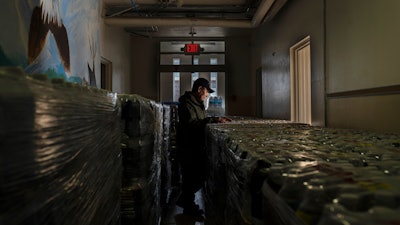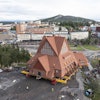
WARM SPRINGS, Ore. (AP) — Erland Suppah Jr. doesn’t trust what comes out of his faucet.
Each week, Suppah and his girlfriend haul a half-dozen large jugs of water from a distribution center run by the Confederated Tribes of Warm Springs to their apartment for everything from drinking to cooking to brushing their teeth for their family of five. It’s the only way they feel safe after countless boil-water notices and weekslong shutoffs on a reservation struggling with bursting pipes, failing pressure valves and a geriatric water treatment plant.
“About the only thing this water is good for is cleaning my floor and flushing down the toilet,” Suppah said of the tap water in the community 100 miles (160 kilometers) southeast of Portland. “That’s it.”
In other, more remote tribal communities across the country, running water and indoor plumbing have never been a reality.
Now, there’s a glimmer of hope in the form of a massive infrastructure bill signed last month that White House officials say represents the largest single infusion of money into Indian Country. It includes $3.5 billion for the federal Indian Health Service, which provides health care to more than 2 million Native Americans and Alaska Natives, plus pots of money through other federal agencies for water projects.
Tribal leaders say the funding, while welcome, won’t make up for decades of neglect from the U.S. government, which has a responsibility to tribes under treaties and other acts to ensure access to clean water. A list of sanitation deficiencies kept by the Indian Health Service has more than 1,500 projects, including wells, septic systems, water storage tanks and pipelines. Some projects would address water contamination from uranium or arsenic.
About 3,300 homes in more than 30 rural Alaska communities lack indoor plumbing, according to a 2020 report. On the Navajo Nation, the largest Native American reservation, about one-third of the 175,000 residents are without running water.
Residents in these places haul water for basic tasks such as washing and cooking, sometimes driving long distances to reach communal water stations. Instead of indoor bathrooms, many use outhouses or lined pails called “honey buckets” that they drag outside to empty. Some shower or do laundry at community sites known as “washeterias,” but the equipment can be unreliable and the fees expensive.
“You look at two billionaires competing to fly into outer space, yet we’re trying to get basic necessities in villages of interior Alaska,” said PJ Simon, a former chairman of an Alaska Native nonprofit corporation called the Tanana Chiefs Conference.
Many more tribal communities have indoor plumbing but woefully inadequate facilities and delivery systems riddled with aging pipes.
The coronavirus pandemic, which disproportionately hit Indian Country, further underscored the stark disparities in access to running water and sewage systems.
In Warm Springs, the water crisis has overlapped with COVID-19.
“During a worldwide pandemic, we’ve had a boil-water notice. How are we supposed to wash our hands? How are we supposed to sanitize our homes to disinfect, to keep our community members safe? How can we do that ... when our water isn’t even clean?” said Dorothea Thurby, who oversees the distribution of free water to tribal members and food boxes to those who are quarantined.
A 2019 report by a pair of nonprofit groups, U.S. Water Alliance and Dig Deep, found Native American homes are 19 times more likely than white households to lack full plumbing. And federal officials note tribal members without indoor toilets or running water are at increased risk of respiratory tract, skin and gastrointestinal infections.
On the Navajo Nation, Eloise Sullivan uses an outhouse and often drives before dawn to beat the crowd at a water-filling station near the Arizona-Utah border to get water for the five people in her household. They use about 850 gallons (3,200 liters) a week, she estimated.
Sullivan, 56, doesn’t mind hauling water, but “for the younger generation, it’s like, ‘Do we have to do that?’”
“It’s kind of like a big issue for them,” she said.
She once asked local officials what it would cost to run a water line from the closest source about 2 miles (3.2 kilometers) away. She said she was told $25,000 and never pursued it.
Libby Washburn, special assistant to President Joe Biden on Native American affairs, recently told tribes the infrastructure bill included enough money to complete all the projects on the Indian Health Service list. The agency said it’s consulting with tribes and won’t make allocation decisions before that process is over.
Until now, tribes and outside organizations have worked to address needs with their own funding, donations or federal money, including pandemic relief.
“If you live without running water, you understand the importance and the connection you have with it, deep down as a person, as a human being,” said Burrell Jones, who sets up water systems and delivers water around Dilkon, Arizona, with Dig Deep’s Navajo Water Project. “You can’t exist without water.”
Andrew Marks recently moved back to Tanana, a community of about 190 people in Alaska’s interior. He initially relied on a washeteria but found the equipment unreliable. He now has running water and plumbing where he lives but hauls water for family members who don’t.
“I believe if we had more people with water, more people connected to the grid, it would drastically improve their life,” he said.
In Oregon, tribal officials have handed out about 3 million gallons (11 million liters) of water — almost all of it donated — from a decommissioned elementary school on the reservation. A steady stream of residents pick up a combined 600 gallons (2,270 liters) of water a day from the building. Former classrooms overflow with 5-gallon (19-liter) containers and cases of bottled water.
“The infrastructure bill brought joy to my heart because now it gives me hope — hope that it’s going to be repaired,” said Dan Martinez, the tribes’ emergency manager, who expects to receive federal funds to replace underground pipes and address the 40-year-old treatment plant.
“If you came to work one day and someone said, ‘Hey, you need to go and find water for a community of 6,000 people.’ ... I mean, where do you start?’”
The money won’t provide immediate relief. Funding to the Indian Health Service is supposed to be distributed over five years. There is no deadline for its use, and projects will take time to complete once started. The money won’t cover operation and maintenance of the systems, a point tribes have criticized.
In Warm Springs, tribal members don’t pay for their water, and proposals to charge for it are deeply unpopular. That provides little incentive for tribal members to conserve water and raises questions about how new infrastructure will be maintained.
“There are some Natives who say — and I believe this myself — ‘How do you sell something you never owned? The Creator has given it to us,’” said Martinez, a tribal member.
Building out infrastructure in remote areas can be onerous, too. Most roads on the Navajo Nation are unpaved and become muddy and deeply rutted after big storms.
In Alaska, winter temperatures can fall well below zero, and construction seasons are short. Having enough people in a small community who are trained on the specifics of a water system so they can maintain it also can be a challenge, said Kaitlin Mattos, an assistant professor at Fort Lewis College in Colorado who worked on a 2020 report on water infrastructure in Alaska.
“Every bit of funding that is allocated is going to help some family, some household, which is wonderful,” she said. “Whether it’s enough to help every single household, I think, remains to be seen.”






















